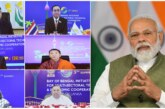India is witnessing a #youth bulge. According to broad estimates, nearly two-thirds of Indians are under 35; half are under 25. By 2020, #India will be the youngest country in the world, with a median age of 29 years. The #population in the age-group of 15-34 increased from 353 million in 2001 to 430 million in 2011. Current predictions suggest a steady increase in the #youthpopulation to 464 million by 2021. India’s large youth population, often called a “#demographicdividend,” could potentially make #Indiathebiggestconsumermarket and the #biggestlaborforceintheworld.
The era of #economicreforms in the 1990s and early 2000s was characterized by relatively high #economicgrowth and during this period India’s youth came of age marked by revolution in #communicationtechnology and this period saw young people growing up more connected to the world — beyond their village, their caste, their co-religionists or their income level — than any previous generation. The information #revolution has familiarized them how the rest of the world — and privileged classes in India live and they have also nurtured heightened expectations.
According to the findings of the 68th Round Survey by the #NationalSampleSurveyOffice (#NSSO), recent years have seen increase in unemployment rate in India. As on January 1, 2010, the number of unemployed was 9.8 million. By January 1, 2012, it had increased to 10.8 million.
Between 2010 and 2012, India has witnessed a work force growth of 13.9 million in just two years. As on January 2010, the workforce at the all-India level was about 459 million which, as on January 2012, increased to 472.9 million. More than half the workforce population (52%) is #selfemployed, while 18% work as regular wage/salaried employees and 30% as casual laborers. More people are self-employed (56%) and work as casual laborers (35%) in #ruralIndia. In #UrbanIndia, it is the waged/salaried (43%) who constitute a majority. They are followed by the self-employed (42%) and casual laborers (15%). Nearly half the population (49%) is engaged in #agriculture, while 24% are working in secondary sector and 27% in tertiary sector.
In the wake of increasing population, the problem of unemployment is likely to worsen, if ample jobs are not created to accommodate the young working population. This calls for a well-concerted national policy to tackle the problem of youth #unemployment. Measures should be undertaken to make jobs more accessible by first of all getting rid of local barriers.
Secondly, many of youth may need re-training or simply the possibility of gaining work experience away from home. Priority should be accorded to setting up cross-town/districtvocationaltraining and #educationalprogrammes through the #Statelevelpolicies. The #SMEs should be encouraged to invest more in the #rightskills for jobs in demand and the government should introduce reforms in the education system to make them more cost-effective and competitive.
#Combatingyouthunemployment should be a priority for State Governments. They should refer to best practices which other countries have successfully applied. The key is to determine whether concepts such as vocational schooling or dual education and training can be applied within their local systems.
The unequal access to opportunity and the lack of emphasis on #education remains a persistent problem. Unfortunately, many young people seldom get the chance of acquiring the skills and education that would raise their living to reasonable levels, even assuming enough jobs were created to employ them. Our education system is simply not delivering: A recent report from Pratham, a nonprofit education advocacy group, reveals that half of India’s 7-year-olds cannot identify letters, and one in five 10-year-olds cannot read sentences.
The Small and Medium Enterprises or #SMEsector in India holds vast potential of generating additional jobs for the youth. While contributing nearly half of the industrial output, 40% of India’s exports, employing 60 million people, his sector creates 1.3 million jobs every year and produce more than 8000 quality products for the Indian and international markets.
According to broad estimates, about 15 million people are expected to join the workforce in next 5 years and the sector growing at a rate of 8% per year. In the recent past, some measures have been undertaken to increase competitiveness of SMEs in the international market. There are several factors that have contributed towards the growth of Indian SMEs. Few of these include; funding of SMEs by local and #foreigninvestors, the new technology that is used in the market is assisting SMEs add considerable value to their business, various trade directories and trade portals help facilitate trade between buyer and supplier and thus reducing the barrier to trade.
However, the #SMEsinIndia, due to their low scale and poor adoption of technology, have very poor productivity. Although they employ 40% of India’s workforce, they only contribute 17% to the #IndianGDP. The reason is that too many firms stay small, unregistered and un-incorporated in the unorganised sector so that they can avoid taxes and regulations. Many SME firms have little incentive to invest in upgrading skills of largely temporary workers or in investing in capital equipment. The #SME sector should be accorded priority in our #nationalplanning.
Information and communication technology is a viable gainful field for the youth. Web design and development can give young people formal #digitalskills and direct experience in the #workplace, while helping business get online in the process.
The low digital capability of many business entities is a huge limitation on their #growth and #productivity. Many entities are without a website; many #youngpeople can design a #ebsite, but lack the training and experience in the workplace to be able to use these skills to get a job. #Civilsociety can help to build a link between the two.
e-Services and eGovernment wield a positive impact on #sustainabledevelopmentandcivilsociety. As eServices continue to mature they have a direct effect on the eGovernment progress of the country. The new challenge for public administration is now to embed the use of digital technologies in the implementation of government policy, achieving real transformation. They will need a deep understanding of the citizens to which those policies apply – the “users” – who increasingly only use mobile devices to access the internet.
There is need for promoting awareness among young people of the opportunities and challenges of entrepreneurship and self-employment, and the role of young people in shaping their future and that of their country’s economic and social development.
Some experts have provided recommendations for the #government, #community and #businesses in order to take the #youthinnovation forward. Some of these recommendations to the government include:
– #National and #localgovernments should work together to make business registration as efficient as possible
– #Governments and #education authorities should include #selfemployment as a viable alternative within careers advice
– Governments should use existing structures such as chambers of commerce to support the #developmentofyouthentrepreneurship
– Governments should encourage #schools and #colleges to run business competitions that promote start-up opportunities
– Governments should prioritize investment in #youthentrepreneurship initiative to tackle #youthunemployment
The new dispensation will have to jump-start the #falteringeconomy, #provideaccesstoaffordable, #improvededucationfortheyouth in all regions and help the private sector create millions of decent-paying jobs. Such steps are essential to prevent India’s youthful demographic dividend from turning into a demographic liability.
By #DrArvindKumarPresidentIndiaWaterFoundation
Article published in SAR Economist/July 2014/P.No.33/



